HALion

Hou la la ! The ECVST didn't propose anything about HALion, what a distress ! However, this VST-instrument had been long-awaited and its release didn't get unnoticed. In order to forgive us for this editorial delay, we're going to do an in-depth overview of HALion, just for you, step by step !
Well, just in case, I'll tell you again that HALion is a sampler. Except that... sampler means reading AND recording. Noooot at all ! HALion can read samples but doesn't have any sample-recording function. Sample player would be therefore more appropriate than sampler, to my own opinion, which is the word I use most often... ;op
Sample reader in VST-i format, then. Let's go for a tour of the domain...
Very simple in fact. You load a sound bank, or only one sound (one instrument) or, more, you create your instrument yourself, and you play. You could like or dislike the graphical interface, the functions, the ergonomics, but the biggest feature of HALion is its capacity to import a very broad variety of formats. Listing them would be tedious, but if I tell you Akai, Gigasampler and Soundfont, you will understand immediately that, with a single plug-in, you have access to an almost unlimited sound library.
Technically, HALion works like this : loading all the sounds in RAM would be suicidal, reading them from a hard disk drive too. As a consequence, Steinberg did 50/50. The beginning of the samples is loaded into RAM for fast access, the remainder of the audio file is read from the hard disk. When using it, it's totally transparent. Let's see now the different parts and functionalities of the program...
Behind this name which means nothing, we find the main window. There, you adjust the general parameters of the "animal", loading of banks or instruments, filters, amplitude envelopes, tune, glissando, etc. Nothing innovating, nothing badly designed. On the other hand, if your eyes are a bit lazy, the colour and the size of the serigraphy will sometimes give you some worries, it's a bit unreadable. It's, besides, a drawback that we meet more and more often.
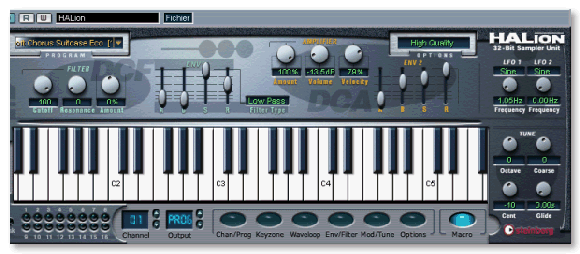
There you will route an instrument (a program in HALion's language) to each of the 16 Midi chanels. Nothing more to say, you just need to choose the desired program from a pop-up menu containing up to 128. One thing to indicate. You must, of course, click on the desired channel in order to attribute it a program later. It would have been judicious for the channel to change its colour when selected because you never know which one is being active. It is one of those little irritating things in HALion, there are some like this, which spoil the pleasure a little.
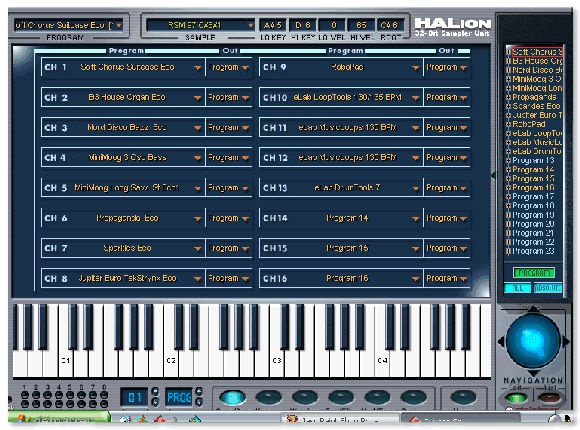
Ouarf, it's getting a little bit complicated ! You must now bring the possibility to edit yourselves a program. It's from this window that you will import the Audio files, place them along the keyboard, make them overlap (but no, it is not a dirty sex thing !), attribute them a velocity, etc.
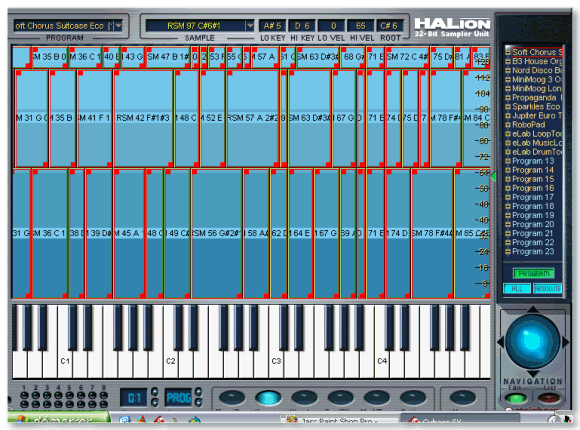
Look here, now, a trick. The import of an Audio file in the "Keyzone" can be done either by the contextual menu, or drag'n'dropping (glisser-déposer, in good English !). But ! SX is opened, HALion is active, hop, you're looking for a sample on the hard disk, damn it ! HALion's window disappears as soon as you switch from SX to Windows Explorer. Nuts ! Do a right-click somewhere in HALion's windows and uncheck "Always in foreground".
So, you import some samples (échantillons, in good English !) and you organize all that with the mouse. Nothing to say, it's useful and even my dog could understand the trick !
Who says sampler says looping. HALion offers two loop-types, a sustain one and a release one with their own parameters. This part of the program is full of functionnalities, you'll have to explore mouse right-clicks a bit and to read the manual fully, otherwise you will miss many tricks. Thus, it is possible for example to generate some input / output loop crossfades.
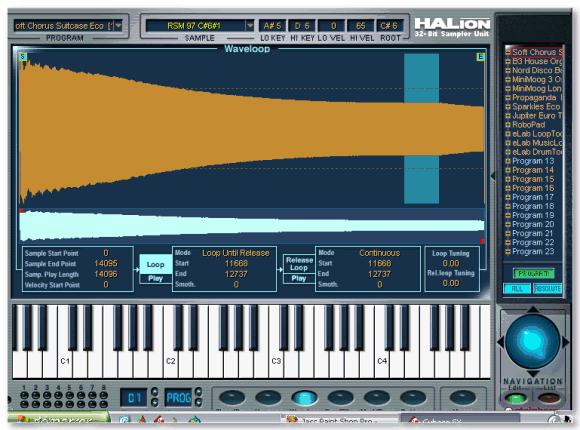
The only fly in the ointment, still another one of these little errors on the ergonomics. Once a sample area is selected for looping, maybe you could be induced to change its size. You just need to select the margin of the selection and move it. Yes, but the shape of the mouse arrow doesn't change whether it is above the border of the selection or above the sample. Bam!, one time out of two, you'll click out of the selection which will be lost. Little game of patience !
There's here a filter envelope and an amplitude envelope,each one having up to 4 (ADSR) with 8 points. For the reminder, you find here the usual parameters, no innovation, only conventional ones !
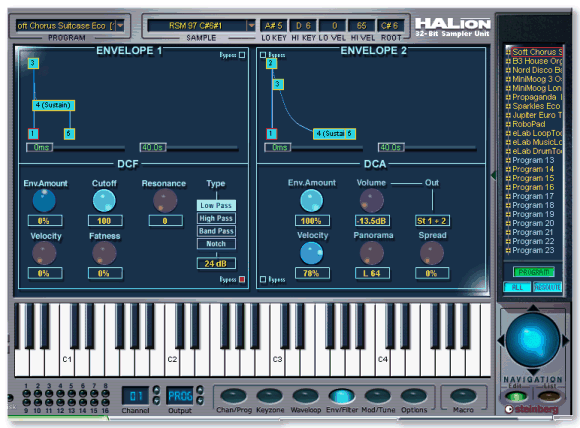
If you frequent forums, you will regularly read there that HALion's filters suck, this notoriety seek after the software. So what ? It's not a technical problem but a fancy matter. I've asked some friends on the subject, some musicians, fans of hardware samplers.Their answer was clear : they think that HALion's filters are "un-musical". I've done several tests on several types of sounds, and it's true that the results are not often pleasant to the ear. Listen and let your ears be judge. For my own use, HALion is before all a soundbank player, so I don't really give a toss about filters !
Modulation and tune, so. Let's pass quickly over tuning possibilities, there's nothing else to say but : it's all packed inside the box ! For the LFOs, they are reduced to the minimum : waveform, frequency and delay. Can't do any big damage, then.
Now, it's getting interesting with the possibilities to module almost all by anything. In short, you choose on the one hand the source (will it be able to module somethin' ?), serrated roller, aftertouch, Midi controllers, HALion's output itself, and on the other hand the target (will it be moduled ?), cutoff, reasonance, pan, volume, pitch... Here is something to play with fora little while !
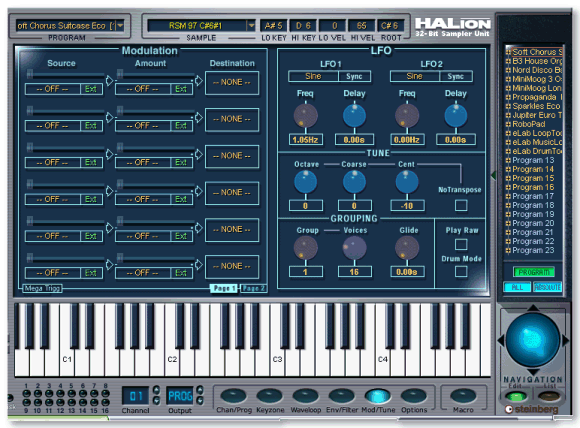
Here, it becomes bluntly exciting, it's when you enter the Mega Trigg function (since version 1.1). What's that ? A system which makes it possible to start an event if one or several conditions are put together. Example : "If it is a note-on, play this sample, if it is a note-off, play this other sample". And this is the way you have a sound when you play a key and another one when you release it. It allows some prospects, doesn't it ?
Here, there are some general adjustments, memory, volume, but especially... especially the import functions of Akai, Gigasampler, Soundfont, LM4/LM9 banks, etc.
And now, hup!, a bit of buddy-buddy relationship ;o)
This part of the program was designed by the talented Bernard Chavonnet, creator of the brilliant CDXtract ! So, a guarantee quality. Big sample-consumers, besides, will be well advised to have CDXtract near HALion. Bernard, for the cheque, we'll do as we said !
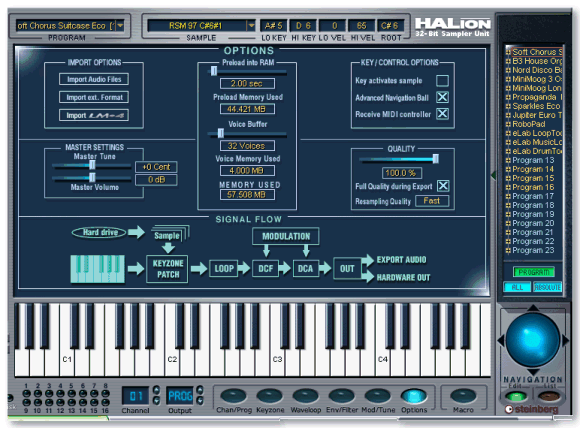
More seriously, imports don't bring any problem, except that you must sometimes be patient, as importing a big Akai program can take some time...
One word about the 1.6 GB of bundled sounds. Some are very good (basses and drums), some are very average (pianos). It's, before all, a fancy matter and I think everybody will find here their little bit of happiness ! But, well, the Import function is here, isn't it ?
As a conclusion, HALion is easy to use if you have a look at the manual... What a shame that some small details on the ergonomics are so inconvenient. It's like this blue ball, very nice most certainly, but I don't think it's that useful. For the reminder, everything works well. The big advantage is the access to a big sound library with only one tool.
even so, allow a rather powerful machine because, whereas you could think that reading a sample wihtout any active filter doesn't need any calculating power, Cubase performance-bar climbs quickly up to 20 % on a P3 at 1 GHz. In the same way, as a part of the samples are loaded into RAM, allow 512 MB in order to breathe comfortably !





